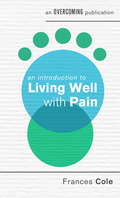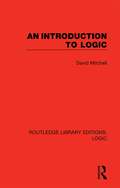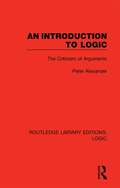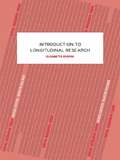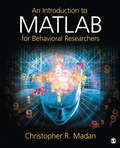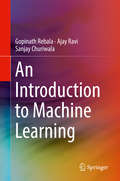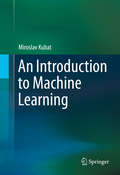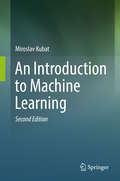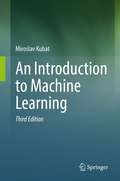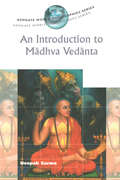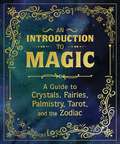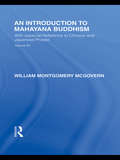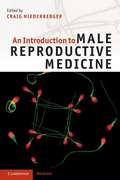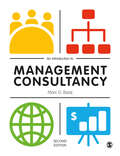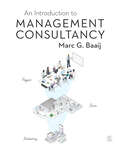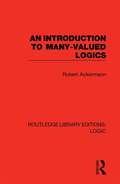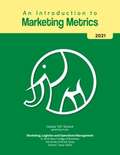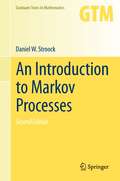- Table View
- List View
An Introduction to Living Well with Pain (An Introduction to Coping series)
by Dr. Frances ColePractical 'footsteps' to help you live well with a chronic pain conditionIf you live with a long term condition that causes you chronic pain, then you are not alone. Chronic or persistent pain affects many adults and children in many ways. It can impact on your mood, your home and work life, your relationships, your sleep, your activities and all areas of your health. It can take your life over. Change is possible. Effective pain management requires a practical multi-focused approach. This self-help guide brings together tools that have worked with thousands of people with pain. It guides you through skills that help you stop struggling and cope well with pain, including:· Goal-setting, making action plans and rewarding yourself· Pacing your day to day activities and building in relaxation practice· Developing healthy exercise and eating routines· Sleeping well again· Coping with setbacks
An Introduction to Logic (Routledge Library Editions: Logic)
by David MitchellOriginally published in 1967. The common aim of all logical enquiry is to discover and analyse correctly the forms of valid argument. In this book concise expositions of traditional, Aristotelian logic and of modern systems of propositional and predicative logic show how far that aim has been achieved.
An Introduction to Logic: The Criticism of Arguments (Routledge Library Editions: Logic)
by Peter AlexanderOriginally published in 1969. This book is for undergraduates whether specializing in philosophy or not. It assumes no previous knowledge of logic but aims to show how logical notions arise from, or are abstracted from, everyday discourse, whether technical or non-technical. It sets out a knowledge of principles and, while not historical, gives an account of the reasons for which modern systems have emerged from the traditional syllogistic logic, demonstrating how certain central ideas have developed. The text explains the connections between everyday reasoning and formal logic and works up to a brief sketch of systems of propositional calculus and predicate-calculus, using both the axiomatic method and the method of natural deduction. It provides a self-contained introduction but for those who intend to study the subject further it contains many suggestions and a sound basis for more advanced study.
An Introduction to Longitudinal Research (Social Research Today)
by Elisabetta RuspiniOne of the major changes in the social science research landscape in recent years has been the introduction of computerised panel surveys in Europe and the US which make longitudinal data widely available to graduate students for the first time. Elisabetta Ruspini here provides a concise yet comprehensive introduction to the issues involved in this kind of research. This book:* Defines the concept of longitudinal research* Gives guidance on sources of longitudinal data in Europe and the US and their strengths and weaknesses* Discusses the choices that need to be made in this kind of research - for instance the advantages and disadvantages of certain types of research data and of different types of analysis* Highlights some of the problems involved, e.g. the issue of comparability within longitudinal research
An Introduction to MATLAB for Behavioral Researchers
by Christopher R. MadanMATLAB is a powerful data analysis program, but many behavioral science researchers find it too daunting to learn and use. An Introduction to MATLAB for Behavioral Researchers by Christopher R. Madan is an easy-to-understand, hands-on guide for behavioral researchers who have no prior programming experience. Written in a conversational and non-intimidating style, the author walks students—step by step—through analyzing real experimental data. Topics covered include the basics of programming, the implementation of simple behavioral analyses, and how to make publication-ready figures. More advanced topics such as pseudo-randomization of trial sequences to meet specified criteria and working with psycholinguistic data are also covered. Interesting behavioral science examples and datasets from published studies, such as visualizing fixation patterns in eye-tracking studies and animal search behavior in two-dimensional space, help develop an intuition for data analysis, which is essential and can only be developed when working with real research problems and real data.
An Introduction to Machine Learning
by Sanjay Churiwala Gopinath Rebala Ajay RaviJust like electricity, Machine Learning will revolutionize our life in many ways – some of which are not even conceivable today. This book provides a thorough conceptual understanding of Machine Learning techniques and algorithms. Many of the mathematical concepts are explained in an intuitive manner. The book starts with an overview of machine learning and the underlying Mathematical and Statistical concepts before moving onto machine learning topics. It gradually builds up the depth, covering many of the present day machine learning algorithms, ending in Deep Learning and Reinforcement Learning algorithms. The book also covers some of the popular Machine Learning applications. The material in this book is agnostic to any specific programming language or hardware so that readers can try these concepts on whichever platforms they are already familiar with. Offers a comprehensive introduction to Machine Learning, while not assuming any prior knowledge of the topic;Provides a complete overview of available techniques and algorithms in conceptual terms, covering various application domains of machine learning;Not tied to any specific software language or hardware implementation.
An Introduction to Machine Learning
by Miroslav KubatThis book presents basic ideas of machine learning in a way that is easy to understand, by providing hands-on practical advice, using simple examples, and motivating students with discussions of interesting applications. The main topics include Bayesian classifiers, nearest-neighbor classifiers, linear and polynomial classifiers, decision trees, neural networks, and support vector machines. Later chapters show how to combine these simple tools by way of "boosting," how to exploit them in more complicated domains, and how to deal with diverse advanced practical issues. One chapter is dedicated to the popular genetic algorithms.
An Introduction to Machine Learning
by Miroslav KubatThis book presents basic ideas of machine learning in a way that is easy to understand, by providing hands-on practical advice, using simple examples, and motivating students with discussions of interesting applications. The main topics include Bayesian classifiers, nearest-neighbor classifiers, linear and polynomial classifiers, decision trees, neural networks, and support vector machines. Later chapters show how to combine these simple tools by way of "boosting," how to exploit them in more complicated domains, and how to deal with diverse advanced practical issues. One chapter is dedicated to the popular genetic algorithms.
An Introduction to Machine Learning
by Miroslav KubatThis textbook offers a comprehensive introduction to Machine Learning techniques and algorithms. This Third Edition covers newer approaches that have become highly topical, including deep learning, and auto-encoding, introductory information about temporal learning and hidden Markov models, and a much more detailed treatment of reinforcement learning. The book is written in an easy-to-understand manner with many examples and pictures, and with a lot of practical advice and discussions of simple applications. The main topics include Bayesian classifiers, nearest-neighbor classifiers, linear and polynomial classifiers, decision trees, rule-induction programs, artificial neural networks, support vector machines, boosting algorithms, unsupervised learning (including Kohonen networks and auto-encoding), deep learning, reinforcement learning, temporal learning (including long short-term memory), hidden Markov models, and the genetic algorithm. Special attention is devoted to performance evaluation, statistical assessment, and to many practical issues ranging from feature selection and feature construction to bias, context, multi-label domains, and the problem of imbalanced classes.
An Introduction to Macroscopic Quantum Phenomena and Quantum Dissipation
by Amir O. CaldeiraReviewing macroscopic quantum phenomena and quantum dissipation, from the phenomenology of magnetism and superconductivity to the presentation of alternative models for quantum dissipation, this book develops the basic material necessary to understand the quantum dynamics of macroscopic variables. Macroscopic quantum phenomena are presented through several examples in magnetism and superconductivity, developed from general phenomenological approaches to each area. Dissipation naturally plays an important role in these phenomena, and therefore semi-empirical models for quantum dissipation are introduced and applied to the study of a few important quantum mechanical effects. The book also discusses the relevance of macroscopic quantum phenomena to the control of meso- or nanoscopic devices, particularly those with potential applications in quantum computation or quantum information. It is ideal for graduate students and researchers.
An Introduction to Madhva Vedanta (Ashgate World Philosophies Series)
by Deepak SarmaThis introduction to the Madhva school of Vedanta is accessible to a wide audience with interest in Hinduism, Indian thought and in the comparative philosophy of religion. Deepak Sarma explores the philosophical foundations of Madhva Vedanta and then presents translations of actual debates between the Madhva and Advaita schools of Vedanta, thus positioning readers at the centre of the 700 year-old controversy between these two schools of Vedanta. Original texts of Madhvacarya are included in an appendix, in translation and in Sanskrit.
An Introduction to Magic: A Guide to Crystals, Fairies, Palmistry, Tarot, and the Zodiac
by Nikki Van De Car Mikaila Adriance Pliny T. Young Eugene FletcherBegin your magical practice with this beautifully illustrated introduction to crystals, the zodiac, tarot, palmistry, and fairies. Start an exploration of some of the most popular mystical topics with An Introduction to Magic! This accessible primer brings together everything you need to know to begin a magical practice, with chapters on crystals, astrology, tarot, palm reading, and fairies from around the world. Learn the meaning and healing properties of the most common magic crystals; the basics of the zodiac signs; the meaning of the Major and Minor Arcana of the tarot; how to conduct a palm reading; and the stories behind popular global fairies. Each chapter is written by a seasoned expert and features stunning illustrations tailored to the topic, to enhance your reading experience.
An Introduction to Mahāyāna Buddhism: With especial Reference to Chinese and Japanese Phases (Routledge Library Editions: Japan)
by William M McGovernWilliam Montgomery McGovern’s Introduction to Mahayana Buddhism was one of the first books on Mahayana Buddhism written for a Western audience. It predates influential English language overviews of Buddhism by D. T. Suzuki, A. Watts, and W. Rahula. The author was born in New York City in 1897 and spent his latter teenage years (1914-1917) training at the Nishi Hongwanji Mahayana Buddhist monastery in Kyoto, Japan. He founded the Mahayana Association at age eighteen and edited and published the journal "Mahayanist" while completing his studies at the monastery. Introduction to Mahayana Buddhism was written as part of a thesis which secured him his Buddhist degree and an honorary ordination as a Buddhist priest. Intended as a simplified and introductory text for a lay audience, the book reflects the unique perspective of a Westerner trained in Japan at a time when Mahayana Buddhism was little known in the West. Referencing Buddhist literature, it gives a short history of Buddhism and the divergence of schools of Buddhist philosophy, introduces the four noble truths, the philosophy of Karma, the nature of Buddhahood, reincarnation and the road to nirvana, Buddhist cosmology, and psychological and philosophical elements of Buddhist teachings. Although the divisions of non Mahayana Buddhist sects and philosophy described may be considered dated, Introduction to Mahayana Buddhism remains significant for its historical value in presenting Eastern religious and philosophical thought to Westerners at a pivotal time in history.
An Introduction to Male Reproductive Medicine
by Craig NiederbergerAn Introduction to Male Reproductive Medicine is written specifically for readers seeking entry into this fast-moving, complex specialty with a solid understanding of the subject. The first chapters cover the anatomy and physiology, clinical evaluation, surgery, medicine, genetics and laboratory testing involved in the current evaluation and treatment of the infertile male, and the final chapter describes the interaction of the field with female reproductive medicine. Throughout the book, references are directly made to the fourth edition of the major text in the specialty, Infertility in the Male, edited by Larry Lipshultz, Stuart Howards and Craig Niederberger, allowing readers to expand their understanding of specific areas where desired. Each chapter is written by a well-renowned expert in an easy to follow, informal style, making the text ideal for students, residents and general physicians who are seeking to increase their general knowledge of the field.
An Introduction to Management Consultancy
by Marc G. BaaijWhether you are preparing for a management consultancy career or only want to acquire widely applicable consultancy skills, you will need a clear and concise introduction to this area. This fully updated second edition text provides you with a practical, step-by-step guide to learn the proven successful methods and techniques of the world′s leading management consultancy firms. Detailed descriptions and real-life illustrations enable you to develop consultancy skills for structured problem-solving, critical thinking, collaboration and communication. Additionally, this text provides rich insights into the latest developments in the consultancy industry and their firms. It includes alumnus of a top management consultancy firm and is essential reading for aspiring consultants as well as anyone dealing with consultants in their career.
An Introduction to Management Consultancy
by Marc G. BaaijWhether you are preparing for a management consultancy career or only want to acquire widely applicable consultancy skills, you will need a clear and concise introduction to this area. This fully updated second edition text provides you with a practical, step-by-step guide to learn the proven successful methods and techniques of the world′s leading management consultancy firms. Detailed descriptions and real-life illustrations enable you to develop consultancy skills for structured problem-solving, critical thinking, collaboration and communication. Additionally, this text provides rich insights into the latest developments in the consultancy industry and their firms. It includes alumnus of a top management consultancy firm and is essential reading for aspiring consultants as well as anyone dealing with consultants in their career.
An Introduction to Management Consultancy
by Marc G. BaaijWhether you are looking to build on your management studies or experience of working in business, you are likely to have come across management consultancy and will need a clear and concise introduction to this area to help you understand its practices and techniques in order to hire and implement management consultancy in the future. This text provides you with these essentials for success in your studies and later industries when working with and not just for consultancy firms. The text is built around learning objectives to empower your understanding of the 'what', 'how', 'when' and 'why' at macro and micro levels of management consultancy and its stakeholders, and provides you with engaging real life examples and extra web materials for study. As well as full courses on management consultancy, this text will be invaluable to your management knowledge and skill-set across strategy, change, analytics, problem-solving, solution implementation and decision-making as applied by the world's top management consulting firms, such as McKinsey & Company, The Boston Consulting Group, and Bain & Company. Visit the companion website www.sagepub.co.uk/baaij Lecturer's resources Lecturer's guide Teaching notes per chapter Answer guidance to end-of-chapter questions in book Suggested discussion questions Suggested small group assignments Suggested small group field project Lecture slides Option 1: provide all figures of the book on PowerPoint slides Option 2: create complete PowerPoint presentations for each chapter Exercises Exam questions Discussion forum Student resources Templates for developing logical structures Web resources Consultancy publications Consultancy web site, career page Job application preparation services Consultancy institutions
An Introduction to Many-valued Logics (Routledge Library Editions: Logic)
by Robert AckermannOriginally published in 1967. An introduction to the literature of nonstandard logic, in particular to those nonstandard logics known as many-valued logics. Part I expounds and discusses implicational calculi, modal logics and many-valued logics and their associated calculi. Part II considers the detailed development of various many-valued calculi, and some of the important metathereoms which have been proved for them. Applications of the calculi to problems in the philosophy are also surveyed. This work combines criticism with exposition to form a comprehensive but concise survey of the field.
An Introduction to Marketing Metrics
by Gopala Gg" Ganesh“This book has resulted from a successful attempt to build the first undergraduate Marketing Metrics course in the world. To date, the course has been completed by more than 7,000 students- usually in traditional classroom settings and occasionally as an online class as well. Originally called Marketing Tools and Skills, the course was eventually renamed as Marketing and Money and then renamed again as Marketing Metrics (MM). This final name is the right one because metrics is the core topic of the course. I view MM as my magnum opus, my unique and hopefully long-lasting contribution to the marketing discipline.” – by the author.
An Introduction to Markov Processes (Graduate Texts in Mathematics #230)
by Daniel W. StroockThis book provides a rigorous but elementary introduction to the theory of Markov Processes on a countable state space. It should be accessible to students with a solid undergraduate background in mathematics, including students from engineering, economics, physics, and biology. Topics covered are: Doeblin's theory, general ergodic properties, and continuous time processes. Applications are dispersed throughout the book. In addition, a whole chapter is devoted to reversible processes and the use of their associated Dirichlet forms to estimate the rate of convergence to equilibrium. These results are then applied to the analysis of the Metropolis (a. k. a simulated annealing) algorithm. The corrected and enlarged 2nd edition contains a new chapter in which the author develops computational methods for Markov chains on a finite state space. Most intriguing is the section with a new technique for computing stationary measures, which is applied to derivations of Wilson's algorithm and Kirchoff's formula for spanning trees in a connected graph.
An Introduction to Markov State Models and Their Application to Long Timescale Molecular Simulation (Advances in Experimental Medicine and Biology #797)
by Gregory R. Bowman Vijay S. Pande Frank NoéThe aim of this book volume is to explain the importance of Markov state models to molecular simulation, how they work, and how they can be applied to a range of problems. The Markov state model (MSM) approach aims to address two key challenges of molecular simulation: 1) How to reach long timescales using short simulations of detailed molecular models. 2) How to systematically gain insight from the resulting sea of data. MSMs do this by providing a compact representation of the vast conformational space available to biomolecules by decomposing it into states sets of rapidly interconverting conformations and the rates of transitioning between states. This kinetic definition allows one to easily vary the temporal and spatial resolution of an MSM from high-resolution models capable of quantitative agreement with (or prediction of) experiment to low-resolution models that facilitate understanding. Additionally, MSMs facilitate the calculation of quantities that are difficult to obtain from more direct MD analyses, such as the ensemble of transition pathways. This book introduces the mathematical foundations of Markov models, how they can be used to analyze simulations and drive efficient simulations, and some of the insights these models have yielded in a variety of applications of molecular simulation.
An Introduction to Marriage and Family Therapy
by Joseph L. Wetchler Lorna L. HeckerNow in its second edition, this text introduces readers to the rich history and practice of Marriage and Family Therapy, with 32 professionals from across the US presenting their knowledge in their areas of expertise. This blend of approaches and styles gives this text a unique voice and makes it a comprehensive resource for graduate students taking their first course in Marriage and Family Therapy. The book is divided into three sections: Part 1 focuses on the components on which 21st century family therapy is based and summarizes the most recent changes made to not only therapeutic interventions, but to the very concept of "family." Part 2 presents an overview of the 7 major theoretical models of the field: structural, strategic, Milan, social constructionist, experiential, transgenerational, and cognitive-behavioral family therapy. Each chapter in this section * Focuses on the founder of the theory, its theoretical tenants, and its key techniques* Shows how the model focuses on diversity* Presents the research that supports the approach Part 3 addresses specific treatment areas that are common to marriage and family therapists, such as sex therapy, pre-marital therapy, research, and ethics and legal issues. As an introduction to the field of Marriage and Family Therapy, this volume stands above the rest. Not only will readers gain an understanding of the rich history of the field and its techniques, but they will also see a complete picture of the context in which families are embedded, such as gender, culture, spirituality, and sexual orientation. This knowledge is the key to understanding what differentiates Marriage and Family Therapy from individual psychotherapy. Glossaries, case studies, tables, figures, and appendices appear generously throughout the text to present this information and give students a thorough overview to prepare them for their professional lives.
An Introduction to Materials Informatics: The Elements of Machine Learning
by Tongyi ZhangThis textbook educates current and future materials workers, engineers, and researchers on Materials Informatics. Volume I serves as an introduction, merging AI, ML, materials science, and engineering. It covers essential topics and algorithms in 11 chapters, including Linear Regression, Neural Networks, and more. Suitable for diverse fields like materials science, physics, and chemistry, it enables quick and easy learning of Materials Informatics for readers without prior AI and ML knowledge.
An Introduction to Materials and Chemistry: Book 1 (Science for Conservators)
by Joyce H. TownsendThis new edition of An Introduction to Materials and Chemistry, book 1 in the updated Science for Conservators series, provides conservators and conservators-in-training with a very basic introduction to the language of chemistry and to the scientific approach. Drawing on 40 years of experience as a conservation scientist, Joyce H. Townsend takes readers through the elementary steps that will enable them to understand and investigate materials in historic objects, and those modern materials used to conserve them, in scientific terms. The book also introduces basic chemistry concepts. It provides worked examples and exercises throughout. This new edition has been significantly expanded and updated, with new material about health and safety, sustainability, and the trend to use greener materials, amongst other topics. The book also includes all-new illustrations, a list of further reading and is accompanied by a Companion Website, which features additional examples, illustrations and more. An Introduction to Materials and Chemistry assumes no previous scientific knowledge and will be essential reading for pre-program applicants to, and students already on, postgraduate conservation programs worldwide. It will also be useful to conservators who are looking to refresh their knowledge or to fill gaps in their training, and for those who trained in languages other than English, but now work in that language.
An Introduction to Mathematical Analysis for Economic Theory and Econometrics
by Juraj Zeman Dean Corbae Maxwell StinchcombeProviding an introduction to mathematical analysis as it applies to economic theory and econometrics, this book bridges the gap that has separated the teaching of basic mathematics for economics and the increasingly advanced mathematics demanded in economics research today. Dean Corbae, Maxwell B. Stinchcombe, and Juraj Zeman equip students with the knowledge of real and functional analysis and measure theory they need to read and do research in economic and econometric theory. Unlike other mathematics textbooks for economics, An Introduction to Mathematical Analysis for Economic Theory and Econometrics takes a unified approach to understanding basic and advanced spaces through the application of the Metric Completion Theorem. This is the concept by which, for example, the real numbers complete the rational numbers and measure spaces complete fields of measurable sets. Another of the book's unique features is its concentration on the mathematical foundations of econometrics. To illustrate difficult concepts, the authors use simple examples drawn from economic theory and econometrics. Accessible and rigorous, the book is self-contained, providing proofs of theorems and assuming only an undergraduate background in calculus and linear algebra. Begins with mathematical analysis and economic examples accessible to advanced undergraduates in order to build intuition for more complex analysis used by graduate students and researchers Takes a unified approach to understanding basic and advanced spaces of numbers through application of the Metric Completion Theorem Focuses on examples from econometrics to explain topics in measure theory
